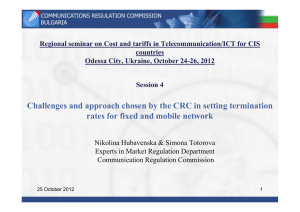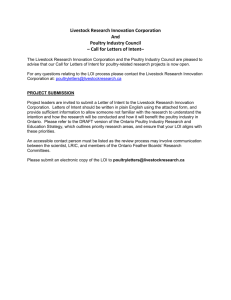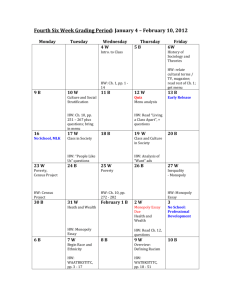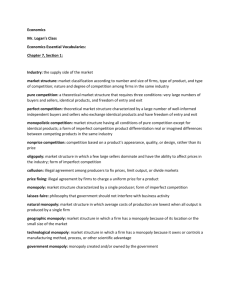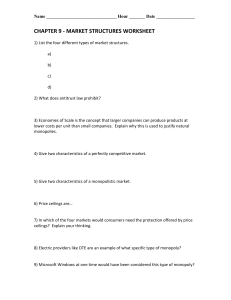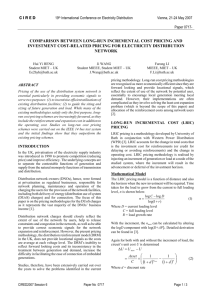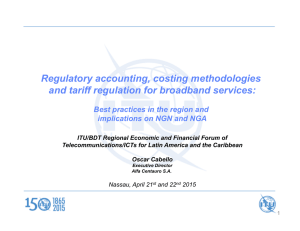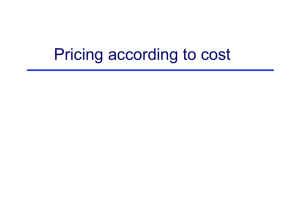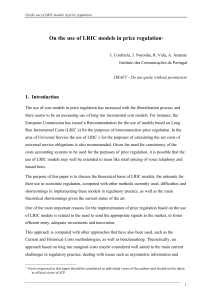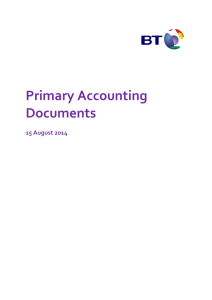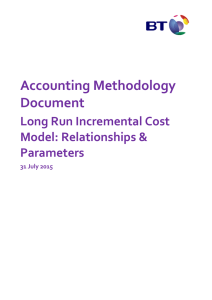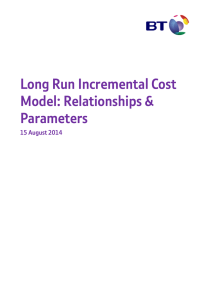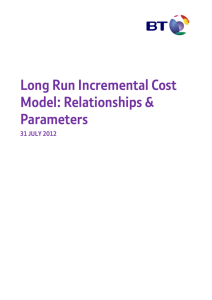Access - British Institute of International and Comparative Law
advertisement
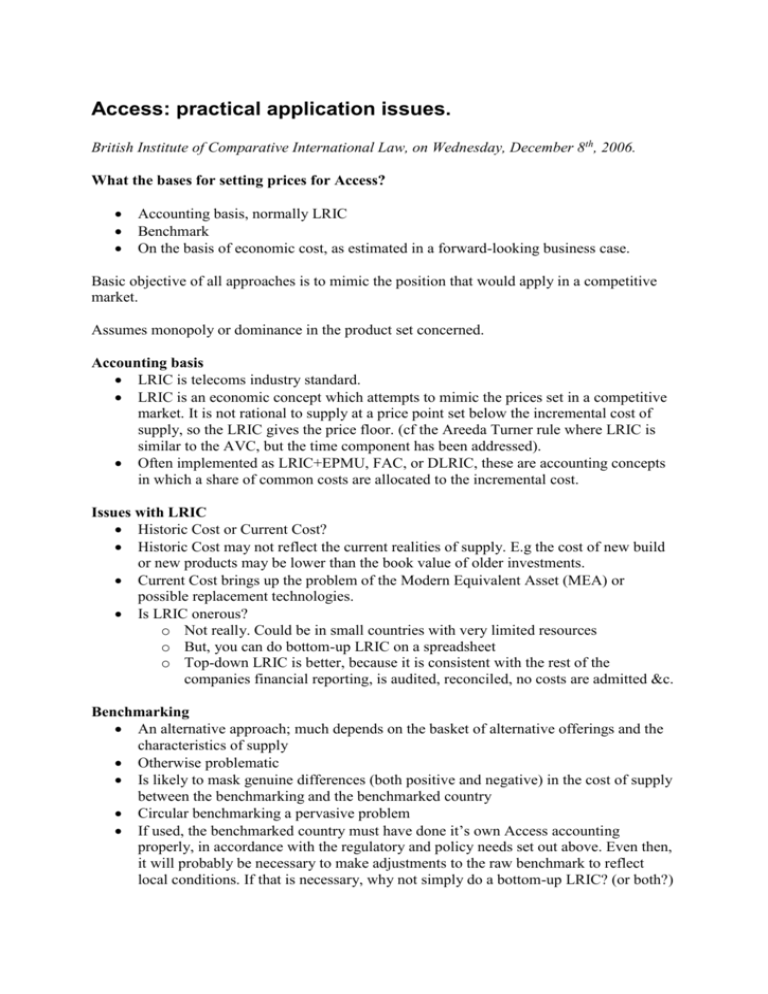
Access: practical application issues. British Institute of Comparative International Law, on Wednesday, December 8th, 2006. What the bases for setting prices for Access? Accounting basis, normally LRIC Benchmark On the basis of economic cost, as estimated in a forward-looking business case. Basic objective of all approaches is to mimic the position that would apply in a competitive market. Assumes monopoly or dominance in the product set concerned. Accounting basis LRIC is telecoms industry standard. LRIC is an economic concept which attempts to mimic the prices set in a competitive market. It is not rational to supply at a price point set below the incremental cost of supply, so the LRIC gives the price floor. (cf the Areeda Turner rule where LRIC is similar to the AVC, but the time component has been addressed). Often implemented as LRIC+EPMU, FAC, or DLRIC, these are accounting concepts in which a share of common costs are allocated to the incremental cost. Issues with LRIC Historic Cost or Current Cost? Historic Cost may not reflect the current realities of supply. E.g the cost of new build or new products may be lower than the book value of older investments. Current Cost brings up the problem of the Modern Equivalent Asset (MEA) or possible replacement technologies. Is LRIC onerous? o Not really. Could be in small countries with very limited resources o But, you can do bottom-up LRIC on a spreadsheet o Top-down LRIC is better, because it is consistent with the rest of the companies financial reporting, is audited, reconciled, no costs are admitted &c. Benchmarking An alternative approach; much depends on the basket of alternative offerings and the characteristics of supply Otherwise problematic Is likely to mask genuine differences (both positive and negative) in the cost of supply between the benchmarking and the benchmarked country Circular benchmarking a pervasive problem If used, the benchmarked country must have done it’s own Access accounting properly, in accordance with the regulatory and policy needs set out above. Even then, it will probably be necessary to make adjustments to the raw benchmark to reflect local conditions. If that is necessary, why not simply do a bottom-up LRIC? (or both?) Economic cost as estimated in a forward looking business case Another way of looking at available evidence and seeking to draw from it the inference of the reasonably efficient downstream operator’s costs; problematic but may be informative. The problems of setting an allowable return apply here as well, as do the difficulties of attributing an appropriate share of common costs,; Asset lives are often very long for Access (30 year averages are not unusual), therefore the NPV is very small; and All forward-looking business cases suffer from forecasting error In practice, this approach is on likely to be adopted as a adjunct to the accounting approach, i.e trends observed in the accounting data will be projected to produce the forward looking case. How is the Monopoly price issue resolved? In Clear Communications vs Telecom New Zealand the Courts were asked to resolve a dispute on what the meaning of the “use “of a dominant position was. TCNZ tried to advance the arguments that the idea that in a fully contestable market someone selling to a competitor the facilities necessary to provide a service the seller could otherwise provide can charge the price equal to the revenues that would have been obtained. This allowed the seller to obtain the lost opportunity cost. The other provisions of the NZ legislation that were designed to regulate prices had not been activated so the ability to obtain monopoly rents was possible: Baumol made the point that all downstream players were charged on the same basis and that created fair competition at the downstream, level. So how is the cap on the monopoly price addressed? Often under regulation not competition law. Telecoms is Capital intensive, therefore allowable Return on Capital Employed (ROCE) very important In effect the set return on capital employed is set as a proxy for a non monopoly profit. The Weighted Average Cost of Capital (WACC) is usually used the set the allowable ROCE. This is usually calculated by using the Capital Asset Pricing Model (CAPM) developed by Modigliani and Miller in the 1950s. There are alternatives to CAPM (Fama-French, multi-factorial models) but all are problematic. A possible consideration: should different WACCs be set for the Access and other parts of the business? This is the position in the UK, but not elsewhere. o Pro: it gives separates the regulated part of the business and recognises it as being inherently low-risk, allowing premia to be sought in the non-regulated, riskier part of the business. o Con: debt providers and equity holders don’t fund (say) LLU, but the company as a whole and all its activities, regulated and non-regulated, high and low risk. Separate is the issue of value Value of a business and an asset in a business is dependant on the revenue generating nature of the business or the asset concerned. This is an accounting concept and accounts are prepared to allow shareholders to assess the value of a business. The idea of value in ordinary usage is often dependant the idea of the value of a good. Value is often thought of as being inherent in the good or service concerned. However value is not inherent in a good it is inherent in the exchange. Markets establish value. . Article 82 Goals:-John Vickers (2004) outlined 3 tests for the application of Article 82: Sacrifice test As efficient competitor test The consumer harm test “Sacrifice” test - “but for” tendency to exclude or exploit would this conduct make business sense? Pro: Simple o Con: No intent shown? What standard of behaviour is to be concluded? Not objective in advance/unpredictable. In Clear Communications, 1994 Privy Council page 22: in reviewing the New Zealand law on “use” of dominant position Browne- Wilkinson LJ said: “to ask whether the defendant has acted reasonably or within jurisdiction. If this were, in itself, the test of “use” of a dominant position, then a monopolist firm would be placed in an impossible position. If asked by a competitor to provide an essential service the monopolist could have little idea what, in future, a court would find to be reasonable or justifiable. Different minds can easily reach different views on what is reasonable or justifiable. In their Lordships view, Section 26 must be construed in such a way as to enable the monopolist, before he enters upon a line of conduct, to know with some certainty whether or not it is lawful”. What is the harm to competition? There may be none. The “as efficient competitor” test:- i.e prevent behaviour that would exclude an as-efficient competitor. o Pro: In UK, EU, US and NZ, cases and Posner suggests as a general standard. “A monopolist is entitled, like everyone else; to compete within it’s competitors: if it is not permitted to do so it would be holding an umbrella over inefficient competitors.” See Olympia Equipment Leasing Company v Western Union Telegraph; Company F.2d.370 (7th Cir.1986) per Posner J. also Clear Communications 1994 Privy Council. o Con: Might promote inefficient entry; might exclude inefficient rivals or alternative business models that improve social welfare: may restrict efficient selective below cost pricing: scope for development as “objective justification”? The “consumer harm” test: I.e law should prevent the exclusion of rivals whose presence enhances consumer welfare. o Market power is the ability to raise price/restrict output therefore to be exclusionary, conduct must be capable of maintaining/ strengthening market power i.e not exclusionary if not raise price/restrict output: o pro: theoretically attractive. Con: Impractical and unpredictable. What standard of proof? -forseeability of effects/actual/probable? Or merely likely/possibility of causing harm: is this an objective intent standard? Does protecting the process of competition include protecting “residual” competition? What is residual competition? Economic Theories “If an economist finds something - a business practice of one sort or another - he does not understand, he looks for a monopoly explanation. And as in this field we are very ignorant, the number of un-understandable practices tends to be very large and the reliance on monopoly explanation frequent” …Ronald Coase 1972 Quoted with approval from John Vickers 2004 Caution Required! DOJ recommendation to the Anti Trust Modernisation Commission Sherman Act section 2 cases - those alleging monopolisation or attempted monopolisation - are highly dependent on specific facts and economic analysis. A company may not realise it has violated section 2 until well after the fact Recommendation: The Commission should study whether consumers would be better off in a system that excludes these cases from the prospect of post-hoc private lawsuits in which damages payable to the plaintiff are automatically trebled. This is one of a number of recommendations for “Modernisation” of US Anti Trust. All authorities concerned to “do the right thing”. There is no “magic bullet”. The US does not have all the answers. :- “Knowing where you are before the law” basic principle of due process/human rights. Predictability is the essence of legal/economic certainty. As John Vickers recognised in his paper to the Competition Commission there is a case for joint handling of law and economics to ensure predictability. Question :- To make the law more predictable is it legally right to alter the remedy? Issues of evidence and proof affect the economic consequences. Difficult cases may give rise to serious harm to competition, and may be just as serious as a simple abuse more easily proved; the case for knowledgeable authorities organised by industrial sectors is high. Compare Ulf Boge IBA speech and Competition Commission speeches on need for swift intervention. Policy developments: Access cases Article 82: Access: abuse is a species of exclusion/ foreclosure. Type of refusal to supply Access to network facility/upstream monopoly: prices/terms & conditions have to be mandated as do the principles against which costs and prices are to be determined. From an economic consequences and structure of industry/competition policy perspective: o Access conditions/prices determine industrial structure: infrastructure/services o Access conditions/prices determine type of entry/number of players/dynamics of competition o Access conditions/prices determine “successful” outcomes for regulation/industry The Pricing of access and the cost basis/ principles that are to be adopted have to be defined by the authorities when making decisions in cases. Otherwise the market participants cannot make decisions about investment and have no basis for commercial models or business plans/ cases. (c.f. Commission Decision in Microsoft).
